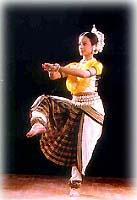Odissi
 The Odissi (Orissi) dance is the Indian classical dance from the Eastern state of Odissa. It has a long, yet broken tradition. Although dance in Odissa may be traced back more than 2000 years, it was brought to near extinction during the colonial period. Therefore, modern Odissi dance is a reconstruction.
The Odissi (Orissi) dance is the Indian classical dance from the Eastern state of Odissa. It has a long, yet broken tradition. Although dance in Odissa may be traced back more than 2000 years, it was brought to near extinction during the colonial period. Therefore, modern Odissi dance is a reconstruction.
History & Origin
Like other forms of Indian classical dance, the Odissi style traces its origins back to antiquity. Dancers are found depicted in bas-relief in the hills of Udaygiri (near Bhubaneshwar) dating back to the 1st century BC. The Natya Shastra speaks of the dance from this region and refers to it as Odra-Magadhi.
Over the centuries three schools of Odissi dance developed: Mahari, Nartaki, and Gotipau. The Mahari tradition is the devadasi tradition; this is the use of women who are attached to deities in the temple. The Nartaki tradition is the school of Odissi dance which developed in the royal courts. Gotipau is a style characteristed by the use of young boys dressed up in female clothing to perform female roles.
Odissi traces its origins to the ritual dances performed in the temples of ancient northern India. Today the name Odissi refers to the dance style of the state of Orissa in eastern India. Like other classical arts of India, this ancient dance style had suffered a decline as temples and artists lost the patronage of feudal rulers and princely states, and by the 1930s and 40s, there were very few surviving practitioners of the art.
 The current form of Odissi is the product of a 20th century revival. Dedicated scholars and dance enthusiasts carefully researched manuscripts and studied the sculpture, painting and poetry of the region. They also met and observed the performances of the few existing performers, in order to revive and restructure Odissi as a unique classical dance style adapted to the requirements of formal stage presentation. Over the years Odissi has become one of the most popular classical dance styles.
The current form of Odissi is the product of a 20th century revival. Dedicated scholars and dance enthusiasts carefully researched manuscripts and studied the sculpture, painting and poetry of the region. They also met and observed the performances of the few existing performers, in order to revive and restructure Odissi as a unique classical dance style adapted to the requirements of formal stage presentation. Over the years Odissi has become one of the most popular classical dance styles.
Odissi dance was held in high esteem before the 17th century. Nobility were known for their patronage of the arts, and it was not unheard of for royalty of both sexes to be accomplished dancers. However, after the 17th century, the social position of dancers began to decline. Dancing girls were considered to be little more than prostitutes, and the "Anti-Nautch" movement of the British brought Odissi dance to near extinction.
Before Independence, the position of Orissi dance was very bad. The tradition of dancing girls at the temple at Puri was abolished. The royal patronage of nartaki had been severely eroded by the absorption of India under the crown. The only viable Odissi tradition was the Gotipau. This had weathered the British Anti-Nautch movement simply because it was danced by males. Yet even the Gotipau tradition was in a very bad state.
Performance & Features
There are a number of characteristics of the Odissi dance. The style may be seen as a conglomeration of aesthetic and technical details.
One of the most characteristic features of Odissi dance is the Tribhangi. The concept of Tribhang divides the body into three parts, head, bust, and torso. Any posture which deals with these three elements is called tribhangi. This concept has created the very characteristic poses which are more contorted than found in other classical Indian dances.
The mudras are also important. The term mudra means "stamp" and is a hand position which signifies things. The use of mudras help tell a story in a manner similar to the hula of Hawaii.
The themes of Odissi are almost exclusively religious in nature. They most commonly revolve around Krishna. Although the worship of Krishna is found throughout India, there are local themes which are emphasised. The Ashtapadi's of Jayadev are a very common theme.
The technique of Odissi includes repeated use of the tribhangi, or thrice deflected posture, in which the body is bent in three places, approximating the shape of a helix. This posture and the characteristic shifting of the torso from side to side, make Odissi a difficult style to execute. When mastered, it is the epitome of fluid grace and has a distinctively lyrical quality that is very appealing.
Like other Indian classical dance forms, Odissi has two major facets: Nritta or non-representational dance, in which ornamental patterns are created using body movements in space and time; and Abhinaya, or stylized mime in which symbolic hand gestures and facial expressions are used to interpret a story or theme.
The divine love tales of Radha and the cowherd God Krishna are favourite themes for interpretation, and a typical recital of Odissi will contain at least one or two ashtapadis (poem of eight couplets) from Jayadeva's Gita Govindam, which describes in exquisite Sanskrit poetry the complex relationship between Radha and her Lord.
- More Dances: Bharatnatyam | Kathak | Kuchipudi | Manipuri | Mohiniattam | Kathakali | Odissi
